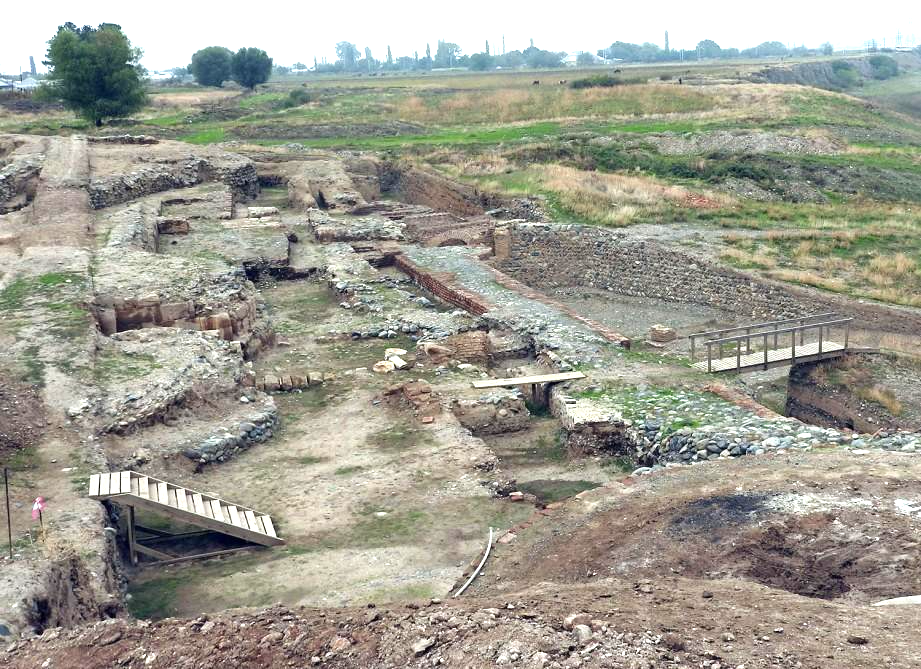|
|
TODAY.AZ / Arts & Entertainment
Gazakh region unveils treasure trove of historical significance [PHOTOS/VIDEO]
28 August 2023 [16:05] - TODAY.AZ

Known for its rich history, Azerbaijan's Gazakh region unveils a treasure trove of historical significance.
The region has a diverse range of archaeological sites, which provide valuable insights into the cultural, social, and economic aspects of ancient societies.
From pottery and tools to architectural remains, each makes it possible to learn more about the region's past.
Launched in 2015, Azerbaijani-Japanese International Archaeological Expedition aims to prove that the area is an ancient human settlement, and to obtain material evidence from the Neolithic era, Azernews reports.
At the initiative of the Culture Ministry, a large delegation led by Professor Yoshihiro Nishiaki was invited to conduct exploration searches at the Avey foothills.
A tripartite international memorandum was signed to explore the world-wide archaeological heritage complex, including Damjili cave, and camp around the cave, on the Avey Mount.

Azerbaijani-Japanese International Archaeological Expedition has recently completed excavations in the Avey State Historical and Cultural Reserve.
Cultural layers of the Middle Paleolithic, Mesolithic, Neolithic, Eneolithic, Bronze Age and Late Middle Ages have been discovered as the result of excavations.
The artifacts found during the latest excavations are artifacts belonging to the transitional period between the Mesolithic and Neolithic.
This created the conditions for the study of Neolithic agricultural activities. The research revealed that 6,000 years ago, there was a transition to the Neolithic culture.
Taking into account the importance of this historical time, archaeological excavations in Damjili Cave are expected to continue in the future.
For more accurate study of the found samples of material culture, the artifacts have been sent to the Institute of Archaeology and Ethnography while the rest of the exhibits will be on display in the reserve.
This is the second intact stratum of Mesolithic culture discovered by archaeologists in Azerbaijan after Gobustan.
Archeological excavations at Damjili cave started in August 2016. Exploratory excavations were carried out in 10 different directions.
Neolithic ruins, hearth places, bones, samples dating the late Middle Paleolithic were discovered at the depth of 4 meters. Research was carried out at Japanese laboratories to determine the periods of the material culture found in Damjili.
Damjili is the largest of the 30 caves of the Stone Age discovered on the territory of Gazakh region in the mid 1950s. Located at the foot of Avey Mount, its area is about 460 square meters and the height is four meters.
Discovered in 1953 by Azerbaijani scientist Mahammadali Huseynov, Damjili Cave is the first monument of the Stone Age discovered in Azerbaijan. It also has similarities with the Goytepe settlement of the Neolithic period in Tovuz region.
A number of various stone tools, arrowheads, flint knives, and bones of animals were discovered in the cave during excavations.
Archaeological excavations in Gazakh contribute to the preservation and conservation of cultural heritage.
By studying and documenting these sites, archaeologists can develop strategies to protect them and ensure that future generations can learn more about Azerbaijan's historical legacy.
URL: http://www.today.az/news/entertainment/238310.html
 Print version
Print version
Connect with us. Get latest news and updates.
See Also
- 23 July 2025 [15:30]
Winners of 'Letter to Vagif' essay contest awarded in Shusha - 23 July 2025 [15:02]
M?tbuArt Int'l Art Symposium showcases artistic unity - 22 July 2025 [15:03]
Culture Ministry holds event involving media representatives - 22 July 2025 [14:01]
Bulbul Vocal School announces student admissions - 21 July 2025 [15:09]
Film-makers Union announces screenwriting contest - 21 July 2025 [12:46]
Movie Night on Seaside Boulevard screens local Films in scenic setting - 18 July 2025 [14:43]
NARGIS Magazine presents Azerbaijani kamancha to Museu de la Música de Barcelona - 18 July 2025 [12:33]
47th session of UNESCO World Heritage Committee wraps up - 18 July 2025 [11:53]
Azerbaijani film to be screened at Kazan International Film Festival - 17 July 2025 [18:16]
Cadenza Orchestra performs its final concert of season
Most Popular
 ??hla Tal?bova recounts trauma of family during Armenian aggression and Khojaly massacre
??hla Tal?bova recounts trauma of family during Armenian aggression and Khojaly massacre
 Russia and Iran launch joint naval drills in Caspian Sea
Russia and Iran launch joint naval drills in Caspian Sea
 Azerbaijani FM Ceyhun Bayramov begins bilateral talks with Georgian counterpart in Tbilisi
Azerbaijani FM Ceyhun Bayramov begins bilateral talks with Georgian counterpart in Tbilisi
 China reports steady progress in agricultural green development
China reports steady progress in agricultural green development
 Azerbaijan leads South Caucasus in patent activity with continued growth in 2024
Azerbaijan leads South Caucasus in patent activity with continued growth in 2024
 Lithuania and new energy sources for Kaliningrad
Lithuania and new energy sources for Kaliningrad
 Have you been taxed? No, you screwed up! - A few words to Grigory Karasin
Have you been taxed? No, you screwed up! - A few words to Grigory Karasin
